Quilting and Sewing Tips & Hints
Applique
Applique is the process of applying one piece of fabric on top of another for decorative or functional purposes.
Making Templates
Most Applique designs are shown as full-size drawings for the completed designs. The drawings show dotted lines to indicate where one piece overlaps another. Other marks indicate placement of embroidery stitches for decorative purposes such as eyes, lips, flowers, etc.
For hand Applique, trace each template onto the right side of the fabric with template right side up. Cut around shape, adding a 1/8" - 1/4" seam allowance.
Before the actual Applique process begins, cut the background block and prepare it for stitching. Most Applique designs are centered on the block. To find the center of the background square, fold it in half and in half again; crease with your fingers. Now unfold and fold diagonally and crease; repeat for other corners referring to Figure 23
. |
| Figure 23 Fold background to mark centers as shown. |
Centerline creases help position the design. If centering the Applique design is important, an X has been placed on each drawing to mark the center of the design. Match the X with the creased center of the background block when placing pieces.
If you have a full-size drawing of the design, as is given with most Applique designs, it might help you to draw on the background block to help with placement. Transfer the design to a large piece of tracing paper. Place the paper on top of the design; use masking tape to hold in place. Trace design onto paper.
If you don't have a light box, tape the pattern on a window; center the background block on top and tape in place. Trace the design onto the background block with a water-erasable marker or chalk pencil. This drawing will mark exactly where the fabric pieces should be placed on the background block.
Hand Applique
Traditional hand Applique uses a template made from the desired finished shape without a seam allowance added.
After fabric is prepared, trace the desired shape onto the right side of the fabric with a water-erasable marker, light lead or chalk pencil. Leave at least 1/2" between design motifs when tracing to allow for the seam allowance when cutting out the shapes.
When the desired number of shapes needed has been drawn on the fabric pieces, cut out shapes leaving 1/8" - 1/4" all around drawn line for turning under.
Turn the shape's edges over on the drawn or stitched line. When turning the edges under, make sharp corners sharp and smooth edges smooth. The fabric patch should retain the shape of the template used to cut it.
When turning in concave curves, clip to seams and baste the seam allowance over as shown in Figure 24.
 |
| Figure 24 Concave curves should be clipped before turning as shown. |
During the actual Applique process, you may be layering one shape on top of another. Where two fabrics overlap, the underneath piece does not have to be turned under or stitched down.
If possible, trim away the underneath fabric when the block is finished by carefully cutting away the background from underneath and then cutting away unnecessary layers to reduce bulk and avoid shadows from darker fabrics showing through on light fabrics.
For hand-Applique, position the fabric shapes on the background block and pin or baste them in place. Using a blind stitch or Applique stitch, sew pieces in place with matching thread and small stitches. Start with background pieces first and work up to foreground pieces. Applique the pieces in place on the background in numerical order, if given, layering as necessary.
Machine Applique
There are several products available to help make the machine-Applique process easier and faster.
Fusible transfer web is a commercial product similar to iron-on interfacings except it has two sticky sides. It is used to adhere Applique shapes to the background with heat. Paper is adhered to one side of the web.
To use, dry-iron the sticky side of the fusible product onto the wrong side of the chosen fabric. Draw desired shapes onto the paper and cut them out. Peel off the paper and dry-iron the shapes in place on the background fabric. The shape will stay in place while you stitch around it. This process adds a little bulk or stiffness to the Appliqued shape and makes hand-quilting through the layers difficult.
For successful machine Applique, a tear-off stabilizer is recommended. This product is placed under the background fabric while machine-Applique is being done. It is torn away when the work is finished. This kind of stabilizer keeps the background fabric from pulling during the machine-Applique process.
During the actual machine-Applique process, you will be layering one shape on top of another. Where two fabrics overlap, the underneath piece does not have to be turned under or stitched down.
Thread the top of the machine with thread to match the fabric patches or with threads that coordinate or contrast with fabrics. Rayon thread is a good choice when a sheen is desired on the finished Applique stitches. Do not use rayon thread in the bobbin; use all-purpose thread.
Set your machine to make a zigzag stitch and practice on scraps of similar weight to check the tension. If you can see the bobbin thread on the top of the Applique, adjust your machine to make a balanced stitch. Different-width stitches are available; choose one that will not overpower the Applique shapes. In some cases these Applique stitches will be used as decorative stitches as well and you may want the thread to show.
If using a stabilizer, place this under the background fabric and pin or fuse in place. Place shapes as for hand-Applique and machine stitch all around shapes.
When all machine work is complete, remove stabilizer from the back referring to the manufacturer's instructions.
Batting
Batting is the material used to give a quilt loft or thickness. It also adds warmth.
Batting size is listed in inches for each pattern to reflect the size needed to complete the quilt according to the instructions. Purchase the size large enough to cut the size you need for the quilt of your choice.
Some qualities to look for in batting are drapeability, resistance to fiber migration, loft and softness.
If you are unsure which kind of batting to use, purchase the smallest size batting available in the type you'd like to try. Test each sample on a small project. Choose the batting that you like working with most and that will result in the type of quilt you need.
Cutting
Quick-cutting
Quick-cutting and piecing strips are recommended for making many projects. Templates are completely eliminated; instead, a rotary cutter, plastic ruler and mat are used to cut fabric pieces.When rotary-cutting strips, straighten raw edges of fabric by folding fabric in fourths across the width as shown in Figure 13.
 |
| Figure 13 Fold fabric and straighten as shown. |
Press down flat; place ruler on fabric square with edge of fabric and make one cut from the folded edge to the outside edge. If strips are not straightened, a wavy strip will result as shown in Figure 14.
| Figure 14 Wavy strips result if fabric is not straightened before cutting. |
Always cut away from your body, holding the ruler firmly with the non-cutting hand. Keep fingers away from the edge of the ruler as it is easy for the rotary cutter to slip and jump over the edge of the ruler if cutting is not properly done.
For many strip-pieced blocks, two strips are stitched together as shown in Figure 15.
| Figure 15 Join 2 strips as shown. |
The strips are stitched, pressed and cut into segments as shown in Figure 16.
| Figure 16 Cut segments from the stitched strip set. |
The cut segments are arranged as shown in Figure 17 and stitched to complete, in this example, one Four-Patch block.
| Figure 17 Arrange cut segments to make a Four-Patch block. |
Although the block shown is very simple, the same methods may be used for more complicated patterns.
The direction to press seams on strip sets is important for accurate piecing later. The normal rule for pressing is to press seams toward the darker fabric to keep the colors from showing through on lighter colors later. For joining segments from strip sets, this rule doesn't always apply.
It is best if seams on adjacent rows are pressed in opposite directions. When aligning segments to stitch rows together, if pressed properly, seam joints will have a seam going in both directions as shown in Figure 18.
 |
| Figure 18 Seams go in both directions at seam joints. |
If a square is required for the pattern, it can be subcut from a strip as shown in Figure 19.
 |
| Figure 19 If cutting squares, cut proper-width strip into same-width segments. Here, a 2" strip is cut into 2" segments to create 2" squares. These squares finish at 1 1/2" when sewn. |
If you need right triangles with the straight grain on the short sides, you can use the same method, but you need to figure out how wide to cut the strip. Measure the finished size of one short side of the triangle. Add 7/8" to this size for seam allowance. Cut fabric strips this width; cut the strips into the same increment to create squares. Cut the squares on the diagonal to produce triangles. For example, if you need a triangle with a 2" finished height, cut the strips 2 7/8" by the width of the fabric.
Cut the strips into 2 7/8" squares. Cut each square on the diagonal to produce the correct size triangle with the grain on the short sides (Figure 20).
 |
| Figure 20 Cut 2" (finished size) triangles from 2 7/8" squares as shown. |
Triangles sewn together to make squares are called half-square triangles or triangle/squares. When joined, the triangle/square unit has the straight of grain on all outside edges of the block.
Another method of making triangle/squares is shown in Figure 21.
 |
| Figure 21 Mark a diagonal line on the square, stitch 1/4" on each side of the line. Cut on line to reveal stitched triangles/squares. |
Layer two squares with right sides together; draw a diagonal line through the center. Stitch 1/4" on both sides of the line. Cut apart on the drawn line to reveal two stitched triangle/squares.
If you need triangles with the straight of grain on the diagonal, such as for fill-in triangles on the outside edges of a diagonal-set quilt, the procedure is a bit different.
To make these triangles, a square is cut on both diagonals; thus, the straight of grain is on the longest or diagonal side (Figure 22).
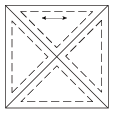 |
| Figure 22 Add 1 1/4" to the finished size of the longest side of the triangle needed and cut on both diagonals to make a quarter-square triangle. |
To figure out the size to cut the square, add 1 1/4" to the needed finished size of the longest side of the triangle. For example, if you need a triangle with a 12" finished diagonal, cut a 13 1/4" square.
If templates are given, use their measurements to cut fabric strips to correspond with that measurement. The template may be used on the strip to cut pieces quickly. Strip cutting works best for squares, triangles, rectangles and diamonds. Odd-shaped templates are difficult to cut in multiple layers using a rotary cutter.
Fabrics
Fabric Choices
Quilts and quilted projects use fabrics of many types, depending on the projects. It is best to combine same-fiber-content fabrics when making quilted items.
Buying Fabrics
One hundred percent cotton fabrics are recommended for making quilts. Choose colors similar to those used in the quilts shown or colors of your own preference. Most quilt designs depend more on contrast of values than on the colors used to create the design.
Preparing the Fabric for Use
Fabrics may be prewashed or not depending on your preference. Whether you do or don't, be sure your fabrics are colorfast and won't run onto each other when washed after use.
Fabric Grain
Fabrics are woven with threads going in a crosswise and lengthwise direction. The threads cross at right angles - the more threads per inch, the stronger the fabric.
The crosswise threads will stretch a little. The lengthwise threads will not stretch at all. Cutting the fabric at a 45-degree angle to the crosswise and lengthwise threads produces a bias edge which stretches a great deal when pulled.
(Figure 1).
 |
| Figure 1 Drawing shows lengthwise, crosswise and bias threads. |
If a template is provided with the pattern, pay careful attention to the grain lines marked with arrows. These arrows indicate that the piece should be placed on the lengthwise grain with the arrow running on one thread. Although it is not necessary to examine the fabric and find a thread to match to, it is important to try to place the arrow with the lengthwise grain of the fabric
(Figure 2).
 |
| Figure 2 Place the template with marked arrow on the lengthwise grain of the fabric. |
Foundation Piecing
Paper or fabric foundation pieces are used to make very accurate blocks, provide stability for weak fabrics, and add body and weight to the finished quilt.
Temporary foundation materials include paper, tracing paper, freezer paper and removable interfacing. Permanent foundations include utility fabrics, nonwoven interfacing, flannel, fleece and batting.
Methods of marking foundations include basting lines, pencils or pens, needlepunching, tracing wheel, hot-iron transfers, copy machine, premarked, stamps or stencils.
There are two methods of foundation piecing; underpiecing and top-piecing. When under-piecing, the pattern is reversed when tracing.
To under-piece, place a scrap of fabric larger than the lined space on the unlined side of the paper in the No. 1 position. Place piece 2 right sides together with piece 1; pin on seam line, and fold back to check that the piece will cover space 2 before stitching.
Stitch along line on the lined side of the paper -- fabric will not be visible. Sew several stitches beyond the beginning and ending of the line. Backstitching is not required as another fabric seam will cover this seam.
Remove pin; finger-press piece 2 flat. Continue adding all pieces in numerical order in the same manner until all pieces are stitched to paper. Trim excess to outside line (1/4" larger all around than finished size of the block).
Tracing paper can be used as a temporary foundation. It is removed when blocks are complete and stitched together. To paper-piece, copy patterns using a copy machine or trace each block individually. Measure the finished paper foundations to ensure accuracy in copying.
Piecing
Hand-Piecing Basics
When hand-piecing, it is easier to begin with templates which do not include the 1/4" seam allowance. Place the template on the wrong side of the fabric, lining up the marked grain line with lengthwise or crosswise fabric grain. If the piece does not have to be reversed, place with labeled side up. Trace around shape; move, leaving 1/2" between the shapes, and mark again.
When you have marked the appropriate number of pieces, cut out pieces, leaving 1/4" beyond marked line all around each piece.
To piece, refer to assembly drawings to piece units and blocks, if provided. To join two units, place the patches with right sides together.
Stick a pin in at the beginning of the seam through both fabric patches, matching the beginning points (Figure 5);
|
| Figure 5 Stick a pin through fabrics to match the beginning of the seam. |
for hand-piecing, the seam begins on the traced line, not at the edge of the fabric (see Figure 6).
 |
| Figure 6 Begin hand-piecing at seam, not at the edge of the fabric. Continue stitching along seam line. |
Thread a sharp needle; knot one strand of the thread at the end. Remove the pin and insert the needle in the hole; make a short stitch and then a backstitch right over the first stitch.
Continue making short stitches with several stitches on the needle at one time. As you stitch, check the back piece often to assure accurate stitching on the seam line. Take a stitch at the end of the seam; backstitch and knot at the same time as shown in Figure 7.
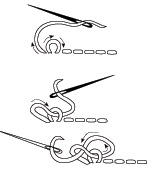 |
| Figure 7 Make a loop in a backstitch to make a knot. |
Seams on hand-pieced fabric patches may be fingerpressed toward the darker fabric.
To sew units together, pin fabric patches together, matching seams. Sew as above except where seams meet; at these intersections, backstitch, go through seam to next piece and backstitch again to secure seam joint.
Not all pieced blocks can be stitched with straight seams or in rows. Some patterns require set-in pieces. To begin a set-in seam on a star pattern, pin one side of the square to the proper side of the star point with right sides together, matching corners. Start stitching at the seam line on the outside point; stitch on the marked seam line to the end of the seam line at the center referring to Figure 8.
 |
| Figure 8 To set a square into a diamond point, match seams and stitch from outside edge to center. |
Bring around the adjacent side and pin to the next star point, matching seams. Continue the stitching line from the adjacent seam through corners and to the outside edge of the square as shown in Figure 9.
 |
| Figure 9 Continue stitching the adjacent side of the square to the next diamond shape in one seam from center to outside as shown. |
Machine-Piecing
If making templates, include the 1/4" seam allowance on the template for machine-piecing. Place template on the wrong side of the fabric as for hand-piecing except butt pieces against one another when tracing.
Set machine on 2.5 or 12-15 stitches per inch. Join pieces as for hand-piecing for set-in seams; but for other straight seams, begin and end sewing at the end of the fabric patch sewn as shown in Figure 10. No backstitching is necessary when machine-stitching.
 |
| Figure 10 Begin machine-piecing at the end of the piece, not at the end of the seam. |
Join units as for hand-piecing referring to the piecing diagrams where needed. Chain-piecing (Figure 11 - sewing several like units before sewing other units) saves time by eliminating beginning and ending stitches.
 |
| Figure 11 Units may be chain-pieced to save time. |
When joining machine-pieced units, match seams against each other with seam allowances pressed in opposite directions to reduce bulk and make perfect matching of seams possible (Figure 12).
 |
| Figure 12 Sew machine-piecing units with seams pressed in opposite directions. |
Templates
Traditional Templates
While many quilt instructions may use rotary-cut strips and quick-sewing methods, a few patterns require templates. Templates are like the pattern pieces used to sew a garment. They are used to cut the fabric pieces which make up the quilt top. There are two types - templates that include a 1/4" seam allowance and those that don't.
Choose the template material and the pattern. Transfer the pattern shapes to the template material with a sharp No. 2 lead pencil. Write the pattern name, piece letter or number, grain line and number to cut for one block or whole quilt on each piece as shown in Figure 3.
 |
| Figure 3 Mark each template with the pattern name and piece identification. |
Some patterns require a reversed piece (Figure 4). These patterns are labeled with an R after the piece letter; for example, A and AR. To reverse a template, first cut it with the labeled side up and then with the labeled side down. Compare these to the right and left fronts of a blouse. When making a garment, you accomplish reversed pieces when cutting
 |
| Figure 4 This pattern uses reversed pieces. |
the pattern on two layers of fabric placed with right sides together. This can be done when cutting templates as well.
If cutting one layer of fabric at a time, first trace the template onto the backside of the fabric with the marked side down; turn the template over with the marked side up to make reverse pieces.
Many Applique patterns do not include a seam allowance. Most designs are given in one drawing rather than individual pieces. This saves space while giving you the complete design to trace on the background block to help with placement of the pieces later. Make templates for each shape using the drawing for exact size. Remember to label each piece as for piecing templates.
For hand Applique, add a seam allowance when cutting pieces from fabric. You may trace the template with label side up on the right side of the fabric if you are careful to mark lightly. The traced line is then the guide for turning the edges under when stitching.
If you prefer to mark on the wrong side of the fabric, turn the template over if you want the pattern to face the same way it does on the page.
For machine Applique, a seam allowance is not necessary. Trace template onto the right side of the fabric with label facing up. Cut around shape on the traced line.
Thread
For most piecing, good-quality cotton or cotton-covered polyester is the thread of choice. Inexpensive polyester threads are not recommended because they can cut the fibers of cotton fabrics.
Choose a color thread that will match or blend with the fabrics in your quilt. For projects pieced with dark and light color fabrics, choose a neutral thread color, such as a medium gray, as a compromise between colors. Test by pulling a sample seam.
Tools & Equipment
There are few truly essential tools and little equipment required for quiltmaking. The basics include needles (hand-sewing and quilting betweens), pins (long, thin sharp pins are best), sharp scissors or shears, a thimble, template materials (plastic or cardboard), marking tools (chalk marker, water-erasable pen and a No. 2 pencil are a few) and a quilting frame or hoop. For piecing and/or quilting by machine, add a sewing machine to the list.
Other sewing basics such as a seam ripper, pincushion, measuring tape and an iron are also necessary. For choosing colors or quilting designs for your quilt, or for designing your own quilt, it is helpful to have graph paper, tracing paper, colored pencils or markers and a ruler on hand.
For making strip-pieced quilts, a rotary cutter, mat and specialty rulers are often used. We recommend an ergonomic rotary cutter, a large self-healing mat and several rulers. If you can choose only one size, a 6" x 24" marked in 1/8" or 1/4" increments is recommended.
Making Continuous Bias Binding
| Instead of cutting individual bias strips and sewing them together, you may make continuous bias binding.
Cut a square 18" x 18" from chosen binding fabric. Cut the square once on the diagonal to make two triangles as shown in Figure 27. |
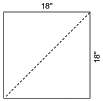 |
| Figure 27 Cut 18" square on the diagonal. |
|
| With right sides together, sew the two triangles together with a 1/4" seam allowance as shown in Figure 28; press seam open to reduce bulk. |  |
| Figure 28 Sew the triangles together. |
|
| Mark lines every 2 1/4" on the wrong side of the fabric as shown in Figure 29. |  |
| Figure 29 Mark lines every 2 1/4" |
|
| Bring the short ends together, right sides together, offsetting one line as shown in Figure 30 to make a tube; stitch. This will seem awkward. | 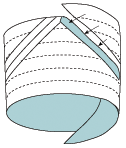 |
| Figure 30 Sew short ends together, offsetting lines to make a tube. |
|
|
Begin cutting at point A as shown in Figure 31; continue cutting along marked line to make one continuous strip. Fold strip in half along length with wrong sides together; press. Sew to quilt edges as instructed previously for bias binding. |
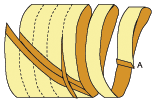 |
| Figure 31 Cut along marked lines, starting at A. |
Final Touches
If your quilt will be hung on the wall, a hanging sleeve is required. Other options include purchased plastic rings or fabric tabs. The best choice is a fabric sleeve, which will evenly distribute the weight of the quilt across the top edge, rather than at selected spots where tabs or rings are stitched, keep the quilt hanging straight and not damage the batting.
To make a sleeve, measure across the top of the finished quilt. Cut an 8"-wide piece of muslin equal to that length - you may need to seam several muslin strips together to make the required length.
Fold in 1/4" on each end of the muslin strip and press. Fold again and stitch to hold. Fold the muslin strip lengthwise with right sides together. Sew along the long side to make a tube. Turn the tube right side out; press with seam at bottom or centered on the back.
Hand-stitch the tube along the top of the quilt and the bottom of the tube to the quilt back making sure the quilt lies flat. Stitches should not go through to the front of the quilt and don't need to be too close together as shown in Figure 32.
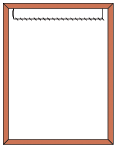 |
| Figure 32 Sew a sleeve to the top back of the quilt. |
Slip a wooden dowel or long curtain rod through the sleeve to hang.
When the quilt is finally complete, it should be signed and dated. Use a permanent pen on the back of the quilt. Other methods include cross-stitching your name and date on the front or back or making a permanent label which may be stitched to the back.
Finishing the Edges
After your quilt is tied or quilted, the edges need to be finished. Decide how you want the edges of your quilt finished before layering the backing and batting with the quilt top.
Without Binding - Self-Finish
There is one way to eliminate adding an edge finish. This is done before quilting. Place the batting on a flat surface. Place the pieced top right side up on the batting. Place the backing right sides together with the pieced top. Pin and/or baste the layers together to hold flat.
Begin stitching in the center of one side using a 1/4" seam allowance, reversing at the beginning and end of the seam. Continue stitching all around and back to the beginning side. Leave a 12" or larger opening. Clip corners to reduce excess. Turn right side out through the opening. Slipstitch the opening closed by hand. The quilt may now be quilted by hand or machine.
The disadvantage to this method is that once the edges are sewn in, any creases or wrinkles that might form during the quilting process cannot be flattened out. Tying is the preferred method for finishing a quilt constructed using this method.
Bringing the backing fabric to the front is another way to finish the quilt's edge without binding. To accomplish this, complete the quilt as for hand or machine quilting. Trim the batting only even with the front. Trim the backing 1" larger than the completed top all around.
Turn the backing edge in 1/2" and then turn over to the front along edge of batting. The folded edge may be machine-stitched close to the edge through all layers, or blind-stitched in place to finish.
The front may be turned to the back. If using this method, a wider front border is needed. The backing and batting are trimmed 1" smaller than the top and the top edge is turned under 1/2" and then turned to the back and stitched in place.
One more method of self-finish may be used. The top and backing may be stitched together by hand at the edge. To accomplish this, all quilting must be stopped 1/2" from the quilt-top edge. The top and backing of the quilt are trimmed even and the batting is trimmed to 1/4" - 1/2" smaller. The edges of the top and backing are turned in 1/4" - 1/2" and blind-stitched together at the very edge.
These methods do not require the use of extra fabric and save time in preparation of binding strips; they are not as durable as an added binding.
Binding
The technique of adding extra fabric at the edges of the quilt is called binding. The binding encloses the edges and adds an extra layer of fabric for durability.
To prepare the quilt for the addition of the binding, trim the batting and backing layers flush with the top of the quilt using a rotary cutter and ruler or shears. Using a walking-foot attachment (sometimes called an even-feed foot attachment), machine-baste the three layers together all around approximately 1/8" from the cut edge.
The list of materials given with each quilt often includes a number of yards of self-made or purchased binding. Bias binding may be purchased in packages and in many colors. The advantage to selfmade binding is that you can use fabrics from your quilt to coordinate colors.
Double-fold, straight-grain binding and double-fold, bias-grain binding are two of the most commonly used types of binding. Double-fold, straight-grain binding is used on smaller projects with right-angle corners. Double-fold, biasgrain binding is best suited for bed-size quilts or quilts with rounded corners.
To make double-fold, straightgrain binding, cut 2"-wide strips of fabric across the width or down the length of the fabric totaling the perimeter of the quilt plus 10". The strips are joined as shown in Figure 17 and pressed in half wrong sides together along the length using an iron on a cotton setting with no steam.
 |
| Figure 17 Join binding strips in a diagonal seam to eliminate bulk as shown. |
Lining up the raw edges, place the binding on the top of the quilt and begin sewing (again using the walking foot) approximately 6" from the beginning of the binding strip. Stop sewing 1/4" from the first corner, leave the needle in the quilt, turn and sew diagonally to the corner as shown in Figure 18.
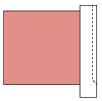 |
| Figure 18 Sew to within 1/4" of corner; leave needle in quilt, turn and stitch diagonally off the corner of the quilt. |
Fold the binding at a 45-degree angle up and away from the quilt as shown in Figure 19 and back down flush with the raw edges. Starting at the top raw edge of the quilt begin sewing the next side as shown in Figure 20. Repeat at the next three corners.
 |
| Figure 19 Fold binding at a 45-degree angle up and away from quilt as shown. |
 |
| Figure 20 Fold the binding strips back down, flush with the raw edge, and begin sewing. |
As you approach the beginning of the binding strip, stop stitching and overlap the binding 1/2" from the edge; trim. Join the two ends with a 1/4" seam allowance and press the seam open. Reposition the joined binding along the edge of the quilt and resume stitching to the beginning.
To finish, bring the folded edge of the binding over the raw edges and blind-stitch the binding in place over the machine-stitching line on the backside. Hand-miter the corners on the back as shown in Figure 21.
 |
| Figure 21 Miter and stitch the corners as shown. |
If you are making a quilt to be used on a bed, you will want to use double-fold, bias-grain bindings because the many threads that cross each other along the fold at the edge of the quilt make it a more durable binding.
Cut 2"-wide bias strips from a large square of fabric. Join the strips as illustrated in Figure 17 and press the in-seams open. Fold the beginning end of the bias strip 1/4" from the raw edge and press. Fold the joined strips in half along the long side, wrong sides together, and press with no steam (Figure 22).
| Figure 22 Fold end in and press strip in half. |
Follow the same procedures as previously described for preparing the quilt top and sewing the binding to the quilt top. Treat the corners just as you treated them with straight-grain binding.
Since you are using biasgrain binding, you do have the option to just eliminate the corners if this option doesn't interfere with the patchwork in the quilt. Round the corners off by placing one of your dinner plates at the corner and rotary cutting the gentle curve (Figure 23).
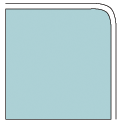 |
| Figure 23 Round corners to eliminate square-corner finishes. |
As you approach the beginning of the binding strip, stop stitching and lay the end across the beginning so it will slip inside the fold. Cut the end at a 45-degree angle so the raw edges are contained inside the beginning of the strip (Figure 24). Resume stitching to the beginning. Bring the fold to the back of the quilt and hand-stitch as previously described.
| Figure 24 End the binding strips as shown. |
Overlapped corners are not quite as easy as rounded ones, but a bit easier than mitering. To make overlapped corners, sew binding strips to opposite sides of the quilt top. Stitch edges down to finish. Trim ends even.
Sew a strip to each remaining side, leaving 1 1/2" - 2" excess at each end. Turn quilt over and fold end in even with previous finished edge as shown in Figure 25.
Fold binding in toward quilt and stitch down as before, enclosing the previous bound edge in the seam as shown in Figure 26. It may be necessary to trim the folded-down section to reduce bulk.
 |
| Figure 25 Fold end of binding even with previous edge. |
 |
| Figure 26 An overlapped corner is not quite as neat as a mitered corner. |
Finishing the Top
Settings
Most quilts are made by sewing individual blocks together in rows which, when joined, create a design. There are several other methods used to join blocks. Sometimes the setting choice is determined by the block's design. For example, a house block should be placed upright on a quilt, not sideways or upside down.
Plain blocks can be alternated with pieced or Appliqued blocks in a straight set. Making a quilt using plain blocks saves time; half the number of pieced or Appliqued blocks are needed to make the same-size quilt as shown in Figure 1.
 |
| Figure 1 Alternate plain blocks with pieced blocks to save time. |
Adding Borders
Borders are an integral part of the quilt and should complement the colors and designs used in the quilt center. Borders frame a quilt just like a mat and frame do a picture. If fabric strips are added for borders, they may be mitered or butted at the corners as shown in Figures 2 and 3.
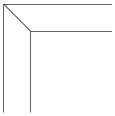 |
| Figure 2 Mitered corners look like this. |
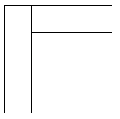 |
| Figure 3 Butted corners look like this. |
To determine the size for butted-border strips, measure across the center of the completed quilt top from one side raw edge to the other side raw edge. This measurement will include a 1/4" seam allowance. Cut two border strips that length by the chosen width of the border. Sew these strips to the top and bottom of the pieced center referring to Figure 4. Press the seam allowance toward the border strips.
Measure across the completed quilt top at the center, from top raw edge to bottom raw edge, including the two border strips already added. Cut two border strips that length by the chosen width of the border. Sew a strip to each of the two remaining sides as shown in Figure 4. Press the seams toward the border strips.
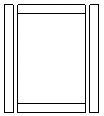 |
| Figure 4 Sew border strips to opposite sides; sew remaining 2 strips to remaining sides to make butted corners. |
To make mitered corners, measure the quilt as before. To this add twice the width of the border and 1/2" for seam allowances to determine the length of the strips. Repeat for opposite sides. Center and sew on each strip, stopping stitching 1/4" from corner, leaving the remainder of the strip dangling. Press corners at a 45-degree angle to form a crease. Stitch from the inside quilt corner to the outside on the creased line. Trim excess away after stitching and press mitered seams open (Figures 5 - 7).
Carefully press the entire quilt top. Avoid pulling and stretching while pressing, which would distort shapes.
 |
| Figure 4 Sew border strips to opposite sides; sew remaining 2 strips to remaining sides to make butted corners. |
 |
| Figure 5 For mitered corner, stitch strip stopping 1/4" from corner seam. |
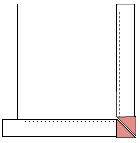 |
| Figure 6 Fold and press corner to make a 45-degree angle. |
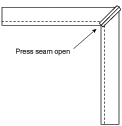 |
| Figure 7 Trim away excess from underneath when stitching is complete. Press seams open. |
Getting Ready to Quilt
Choosing a Quilting Design
If you choose to hand or machine-quilt your finished top, you will need to choose a design for quilting.
There are several types of quilting designs, some of which may not have to be marked. The easiest of the unmarked designs is in-the-ditch quilting. Here the quilting stitches are placed in the valley created by the seams joining two pieces together or next to the edge of an Applique design. There is no need to mark a top for in-the-ditch quilting. Machine quilters choose this option because the stitches are not as obvious on the finished quilt (Figure 8).
 |
| Figure 8 In-the-ditch quilting is done in the seam that joins two pieces. |
Outline-quilting 1/4" or more away from seams or Applique shapes is another no-mark alternative (Figure 9) which prevents having to sew through the layers made by seams, thus making stitching easier.
 |
| Figure 9 Outline-quilting 1/4" away from seam is a popular choice for quilting. |
If you are not comfortable eyeballing the 1/4" (or other distance), masking tape is available in different widths and is helpful to place on straight-edge designs to mark the quilting line. If using masking tape, place the tape right up against the seam and quilt close to the other edge.
Meander or free-motion quilting by machine fills in open spaces and doesn't require marking. It is fun and easy to stitch as shown in Figure 10.
 |
| Figure 10 Machine meander quilting fills in large spaces. |
Marking the Top for Quilting or Tying
If you choose a fancy or all-over design for quilting, you will need to transfer the design to your quilt top before layering with the backing and batting. You may use a sharp medium-lead or silver pencil on light background fabrics. Test the pencil marks to guarantee that they will wash out of your quilt top when quilting is complete; or be sure your quilting stitches cover the pencil marks. Mechanical pencils with very fine points may be used successfully to mark quilts.
Manufactured quilt-design templates are available in many designs and sizes and are cut out of a durable plastic template material which is easy to use.
To make a permanent quilt-design template, choose a template material on which to transfer the design. See-through plastic is the best as it will let you place the design while allowing you to see where it is in relation to your quilt design without moving it. Place the design on the quilt top where you want it and trace around it with your marking tool. Pick up the quilting template and place again; repeat marking.
No matter what marking method you use, remember - the marked lines should never show on the finished quilt. When the top is marked, it is ready for layering.
Preparing the Quilt Backing
The quilt backing is a very important feature of your quilt. In most cases, the materials-list for each quilt gives the size requirements for the backing, not the yardage needed. Exceptions to this are when the backing fabric is also used on the quilt top and yardage is given for that fabric.
A backing is generally cut at least 4" larger than the quilt top or 2" larger on all sides. For a 64" x 78" finished quilt, the backing would need to be at least 68" x 82".To avoid having the seam across the center of the quilt backing, cut or tear one of the right-length pieces in half and sew half to each side of the second piece as shown in Figure 11.
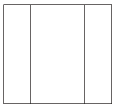 |
| Figure 11 Center one backing piece with a piece on each side. |
Quilts that need backing more than 88" wide may be pieced in horizontal pieces as shown in Figure 12.
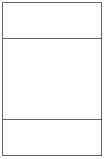 |
| Figure 12 Horizontal seams may be used on backing pieces. |
Layering the Quilt Sandwich
Layering the quilt top with the batting and backing is time-consuming. Open the batting several days before you need it and place over a bed or flat on the floor to help flatten the creases caused from its being folded up in the bag for so long.
Iron the backing piece, folding in half both vertically and horizontally and pressing to mark centers.
If you will not be quilting on a frame, place the backing right side down on a clean floor or table. Start in the center and push any wrinkles or bunches flat. Use masking tape to tape the edges to the floor or large clips to hold the backing to the edges of the table. The backing should be taut.
Place the batting on top of the backing, matching centers using fold lines as guides; flatten out any wrinkles. Trim the batting to the same size as the backing.
Fold the quilt top in half lengthwise and place on top of the batting, wrong side against the batting, matching centers. Unfold quilt and, working from the center to the outside edges, smooth out any wrinkles or lumps.
To hold the quilt layers together for quilting, baste by hand or use safety pins. If basting by hand, thread a long thin needle with a long piece of unknotted white or off-white thread. Starting in the center and leaving a long tail, make 4" - 6" stitches toward the outside edge of the quilt top, smoothing as you baste. Start at the center again and work toward the outside as shown in Figure 13.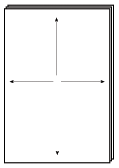 |
| Figure 13 Baste from the center to the outside edges. |
If quilting by machine, you may prefer to use safety pins for holding your quilt sandwich together. Start in the center of the quilt and pin to the outside, leaving pins open until all are placed. When you are satisfied that all layers are smooth, close the pins.
Quilting
Hand-Quilting
Hand-quilting is the process of placing stitches through the quilt top, batting and backing to hold them together. While it is a functional process, it also adds beauty and loft to the finished quilt.
To begin, thread a sharp between needle with an 18" piece of quilting thread. Tie a small knot in the end of the thread. Position the needle about 1/2" to 1" away from the starting point on quilt top. Sink the needle through the top into the batting layer but not through the backing. Pull the needle up at the starting point of the quilting design. Pull the needle and thread until the knot sinks through the top into the batting (Figure 14).
 |
| Figure 14 Start the needle through the top layer of fabric 1/2" - 1" away from quilting line with knot on top of fabric. |
Some stitchers like to take a backstitch at the beginning while others prefer to begin the first stitch here. Take small, even running stitches along the marked quilting line (Figure 15). Keep one hand positioned underneath to feel the needle go all the way through to the backing.
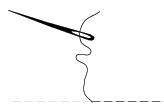 |
| Figure 15 Make sure the running stitches along the marked quilting line are even. |
Machine Quilting
Successful machine quilting requires practice and a good relationship with your sewing machine.
Prepare the quilt for machine quilting in the same way as for hand-quilting. Use safety pins to hold the layers together instead of basting with thread.
Presser-foot quilting is best used for straight-line quilting because the presser bar lever does not need to be continually lifted.
Set the machine on a longer stitch length (three or eight to every ten stitches to the inch). Too tight a stitch causes puckering and fabric tucks, either on the quilt top or backing. An even-feed or walking foot helps to eliminate the tucks and puckering by feeding the upper and lower layers through the machine evenly. Before you begin, loosen the amount of pressure on the presser foot.
Special machine-quilting needles work best to penetrate the three layers in your quilt.
Decide on a design. Quilting-in-the-ditch is not quite as visible, but if you quilt with the feed dogs engaged, it means turning the quilt frequently. It is not easy to fit a rolled-up quilt through the small opening on the sewing machine head.
Meander quilting is the easiest way to machine-quilt - and it is fun. Meander quilting is done using an Applique or darning foot with the feed dogs dropped. It is sort of like scribbling. Simply move the quilt top around under the foot and make stitches in a random pattern to fill the space. The same method may be used to outline a quilt design. The trick is the same as in hand-quilting; you are striving for stitches of uniform size. Your hands are in complete control of the design.
If machine-quilting is of interest to you, there are several very good books available at quilt shops that will help you become a successful machine quilter.
Tied Quilts, or Comforters
Would you rather tie your quilt layers together than quilt them? Tied quilts are often referred to as comforters. The advantage of tying is that it takes so much less time and the required skills can be learned quickly.
If a top will be tied, choose a thick, bonded batting - one that will not separate during washing. For tying, use pearl cotton, embroidery floss, or strong yarn in colors that match or coordinate with the fabrics in your quilt top.
Decide on a pattern for tying. Many quilts are tied at the corners and centers of the blocks and at sashing joints. Try to tie every 4" - 6". Special designs can be used for tying, but most quilts are tied in conventional ways. Begin tying in the center and work to the outside edges.
To make the tie, thread a large needle with a long thread (yarn, floss or crochet cotton); do not knot. Push the needle through the quilt top to the back leaving a 3" - 4" length on top. Move the needle to the next position without cutting thread. Take another stitch through the layers; repeat until thread is almost used up.Cut thread between stitches, leaving an equal amount of thread on each stitch. Tie a knot with the two thread ends. Tie again to make a square knot referring to Figure 16. Trim thread ends to desired length.
 |
| Figure 16 Make a square knot as shown. |
Machine Piecing
Before machine-piecing fabric patches together, test your sewing machine for positioning an accurate 1/4" seam allowance. There are several tools to help guarantee this. Some machine needles may be moved to allow the presser-foot edge to be a 1/4" guide.
A special foot may be purchased for your machine that will guarantee an accurate 1/4" seam. A piece of masking tape can be placed on the throat plate of your sewing machine to mark the 1/4" seam. A plastic stick-on ruler may be used instead of tape with the same results.
Hand Quilting
Use a thimble to prevent sore fingers when hand quilting. The finger that is under the quilt to feel the needle as it passes through the backing is the one that is most apt to get sore from the pin pricks.
Some quilters purchase leather thimbles for this finger while others try home remedies. One simple aid is masking tape wrapped around the finger. With the tape you will still be able to feel the needle, but it will not prick your skin.
Over time calluses build up and these fingers get toughened up, but with every vacation from quilting, they will become soft and the process begins again.
Tip: When you feel your shoulder muscles tensing up, take a rest.
PaperPiecing
If you cannot see the lines on the backside of the paper when paper-piecing, draw over lines with a small felt-tip marker. The lines should now be visible on the backside to help with placement of fabric pieces.
Knotting tips
Knots should not show on the quilt top or back. Learn to sink the knot into the batting at the beginning and ending of the quilting thread for successful stitches.
When you have nearly run out of thread, wind the thread around the needle several times to make a small knot and pull it close to the fabric. Insert the needle into the fabric on the quilting line and come out with the needle 1/2" to 1" away, pulling the knot into the fabric layers the same as when you started. Pull and cut thread close to fabric. The end should disappear inside after cutting. Some quilters prefer to take a backstitch with a loop through it for a knot to end.
Making 12-18 stitches per inch is a nice goal, but a more realistic goal is seven to nine stitches per inch. If you cannot accomplish this right away, strive for even stitches -- all the same size -- that look as good on the back as on the front.
You will perfect your quilting stitches as you gain experience; your stitches will get better with each project and your style will be uniquely your own.

